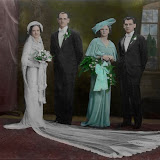http://www.unitedevangelicalucc.org/index.html
In response to a large influx of people immigrating from Germany and settling in the Canton area of Baltimore, Maryland, it became necessary to consider organizing a church. So it was, that on September 14, 1873, a church was organized as Zion Evangelical. Shortly thereafter, the name was changed to the German United Evangelical Church, and remained so until 1937 when the word German was dropped. The board of trustees, as they were called at that time, were Reverend Dr. Andrew Schwartz (Pastor), William Zimmerman (President), John A. Schwartz (Secretary), John Ulrich (Treasurer), George Norris, Henry Guenther, Louis Kiefer, Henry Moll, H.L. Boeschee, Samual Nitzel, Charles J. Spruth, M.F. Reinhardt, R. Winkellmann.
On September 17, 1873, another meeting was held in which the decision to build a sanctuary was resolved. On October 5th the contract was awarded to E. W. Robinson and 104 feet of ground was leased on South East Avenue. The church was completed on April 12, 1874 and dedicated to the “Service of God”. Christian education was a major feature of the church’s early history and in 1876, pioneered one of the first Protestant Sunday schools in the United States.
Early service were conducted in German and the second service in English. However, in 1894, and out of concern of the inclusion of persons of German background into the life of the new country, Pastor Menzel began to confirm members of the church using the English language. The church's history has been one of victory over adversity and deep commitment to mission work.
In 1885 the first parsonage was dedicated. Always concerned with beauty, in 1915 stained glass art windows were installed in the church. The ladies aid, now called women’s organization, presented the painting of “Christ walking the Galilean Sea” which has since been replaced by a beautiful 5’ by 10’ oak carving of the last supper. In 1917 the tower and clock were removed from the old church, saved and placed on the new church. In 1992 the mechanical clock mechanism was replaced and is now controlled by a computer which is programmed to toll its message of security and God’s omnipresence every hour, as well as at the beginning of each Sunday service. The bells can be, and are, rung manually anytime the Lord’s Prayer is said in the church.
In 1927, the church became affiliated with the Evangelical Synod of North America. At about this time, the church became interested in service to the youth of the community and built a Boy’s Brigade in 1930 and the first daily vacation Bible school in 1935. In 1936 ground breaking for the church school took place, and in 1937 the cornerstone for the present parsonage was laid. In those days, the church had a Sunday school enrollment of 500 or more and confirmation classes of 100 or more each year. More space was needed. In 1957 a new sanctuary, the one in use now, was built and dedicated “To the glory of God”.
United Evangelical became part of the United Church of Christ when a merger of the Evangelical and Reformed Churches and the Congregational Church took place in 1957. This merger led to the change in the name of the church to United Evangelical United Church of Christ shortly thereafter. The church, at one time, had a wide range of social and spiritual activities that serve not only the members of the church, but the community as at large. The many activities provided were often in communion with other churches in the Canton area.
The United Evangelical Church is a member of the Chesapeake Association and Central Atlantic Conference of the United Church of Christ. It can be said without doubt, “The church has a rich heritage in both religious traditions and service to the Canton-Highlandtown community”. The members are inheritors of great historical achievements.
Exodus 34,29-35. Last Sunday after Epiphany
2 years ago


